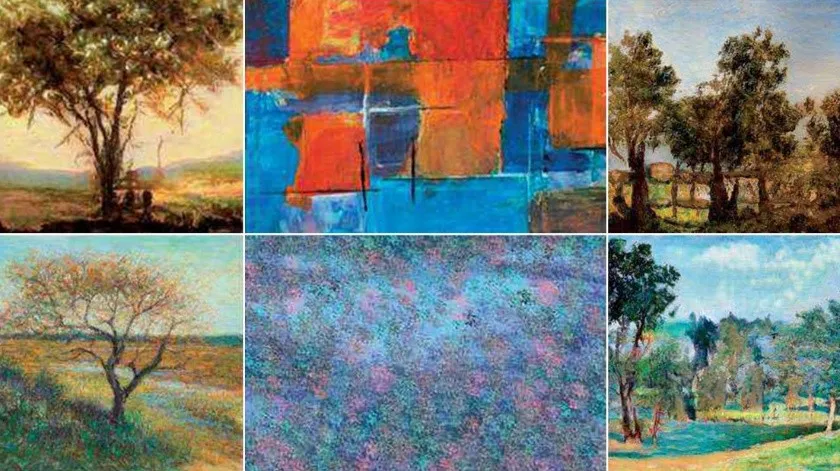AI Painting: Humans Struggle to Differentiate Between Creations by AI and Humans
- Matthew

- May 26, 2023
- 4 min read
Updated: Oct 28, 2024
In a fascinating study published in the journal Empirical Studies within the Arts, researcher Harsha Gangadharbatla delves into the intriguing realm of human perception when it comes to distinguishing between art created by artificial intelligence (AI) and that made by humans. The study involved a survey designed to test participants’ ability to differentiate between human and AI generated artworks using an AI art generator and art generator. The results revealed an intriguing insight into the challenges humans face in discerning the origin of art in the age of AI. The study also highlighted the use of AI painting generator and AI technology, showcasing how these tools transform creative ideas into unique artwork effortlessly.

from Harsha Gangadharbatla studies
The Rise of AI Art
The rise of AI art has revolutionized the way we create and perceive art. With the advent of artificial intelligence, artists and non-artists alike can now generate stunning works of art using AI art generators. These sophisticated tools leverage complex algorithms to analyze and process vast amounts of data, enabling them to produce unique and original pieces of art. This technological advancement has opened up new possibilities for creative expression, allowing individuals to explore different styles and techniques that were previously inaccessible. From digital painting to concept art, AI has democratized the art world, making it possible for anyone to create art with just a few clicks.
Survey Methodology and AI Art Generator
The survey included a collection of landscape paintings and abstract artworks. The human artworks, created by artists Tom Bailey and Steve Johnson, encompassed impressionistic landscapes and geometric abstractions. On the other hand, the computer-generated artworks were produced by an AI algorithm, creating art that challenges traditional boundaries. The goal was to determine whether participants could accurately identify which artworks were crafted by AI and which were the result of human creativity. The findings of the study unveiled a surprising reality – a significant majority of participants struggled to distinguish between AI generated art and human-made art. When examining the landscape paintings, most respondents correctly identified fewer than 20% of the AI generated pieces, with over 75% incorrectly attributing the remaining four artworks. Interestingly, participants exhibited slightly better discernment when it came to abstract artworks, hinting at a potential association of abstraction with AI and subjective art with human creators.

The AI algorithm utilized in the study was capable of replicating and blending different art movements, such as Impressionism and Baroque, allowing for a diverse range of artistic styles in the generated pieces.
Implications and Insights:
The study’s results shed light on the evolving relationship between AI and human creativity, challenging the traditional notion that art is a distinctly human endeavor. The inability to consistently identify AI generated art showcases the remarkable advancements in AI algorithms and their ability to mimic human artistic expression. It raises intriguing questions about the future of art, the blurring boundaries between human and AI creativity, and the evolving role of AI in shaping artistic landscapes.
The Role of Abstraction and Perception:
The study’s observation that participants demonstrated slightly better accuracy in discerning abstract artworks suggests a potential correlation between abstraction and AI-generated art. The objective and unconventional nature of abstract pieces may align more closely with the perceived aesthetic of AI, leading to a more pronounced differentiation. This association highlights the complex interplay between artistic styles, human perception, and the influence of AI in creative domains.
The Blurred Lines Between Human and AI Art
As AI art generators become increasingly sophisticated, the lines between human and AI art are becoming increasingly blurred. Today, it is possible to create art that is almost indistinguishable from that crafted by human hands. This development raises important questions about the role of the artist in the creative process and the intrinsic value of art created using AI. While some critics argue that AI art lacks the emotional depth and personal touch that characterize human art, others view it as a groundbreaking medium that offers endless possibilities for innovation and experimentation. The ability to generate images in various styles, from oil painting to abstract art, challenges our traditional understanding of artistic creation and invites us to reconsider what it means to create art.
The Ethics of AI Art
The use of AI in art also raises important ethical considerations. For instance, who owns the rights to art created using AI? Is it the person who input the prompts, the AI algorithm itself, or someone else entirely? Additionally, there are concerns about the potential for AI art to be used for malicious purposes, such as creating fake or manipulated images. As the use of AI in art continues to evolve, it is essential that we develop clear guidelines and regulations to ensure that this technology is used responsibly and for the benefit of all. Addressing these ethical dilemmas will be crucial in shaping the future of AI art and ensuring that it remains a force for positive creative expression.
Final Thoughts on AI Technology
The study’s findings underline the challenges humans face in distinguishing between art created by AI and humans. AI can now replicate various art styles, including Van Gogh, allowing users to experiment with familiar styles to capture their creative ideas effectively. As AI continues to advance in its artistic capabilities, blurring the lines between human and machine creativity, the definition and perception of art are being redefined. The study provides valuable insights into the impact of AI on the art world and prompts further exploration of the evolving relationship between technology and artistic expression.
If you'd like to know more you can head over to AIArtKingdom.com for a curated collection of today's most popular, most liked AI artwork from across the internet. Plus explore an extensive array of AI tools, complemented by comprehensive guides and reviews, on our AI blog.










